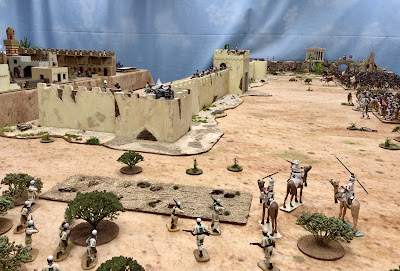 |
| Table layout for The Wargame scenario for the Battle of Mollwitz |
CLICK ON ALL PIX TO ENLARGE
I was searching for a scenario to use for my games at the upcoming Seven Years War Association Convention in South Bend, Indiana the last weekend of March. Willz Harley's pictures of his Mollwitz game, modeled after the Charles Grant game in the classic book "The Wargame", served as the inspiration for my games at this year's convention.
Last weekend I cleared off one of my basement game tables of Sudan terrain and replaced it with verdant green European landscaping and set the table top for the Grant Mollwitz scenario. Since this game has a bit of an Old School element to it, I decided to use my old and veteran Ian Weekley buildings for the game. These building models were made in the mid 1980s and are similar to what might have been used circa 1971 when "The Wargame" was first published.
Here are a few random pictures that I took of the table top to provide a taster for the look of my game at the SYWA convention:
 |
View from the Prussian left flank (Prussians are deployed on the left side of this picture)
and the Austrian right flank. |
 |
| Austrian general Neipperg and his staff ponder on what to do (for all the good that it will do them). |
 |
| Austrian left flank |
 |
| The Austrian Hammer - their right wing cavalry |
 |
| Prussian center marches onto the table. |
 |
View of the battle field with the Austrian right wing cavalry
facing off against the Prussian left wing cavalry. |
One of the interesting aspects of the Charles Grant (senior) Mollwitz scenario is that while the two armies have similar numbers of troops in the game, the Austrians strong suit is their cavalry (6 regiments) to go along with 6-7 battalions of infantry. The Prussians, in contrast, are very weak in cavalry with only 3 regiments, but their strength is in their larger infantry (10-12 battalions) and artillery (5 cannon models versus 3 for the Austrians) combat arms.
Given that the Austrian strength is lined up across the field from the Prussian weakness, that is, cavalry; and likewise the Prussian numbers in infantry face off against the weaker in number Austrian infantry, the battle kind of comes down to which side's strength will prevail first.
It appears that the Austrian cavalry should have an easy time handling their Prussian cavalry counterparts given the disparity in numbers (6 Austrian regiments vs 3 Prussian regiments). So can the Austrian cavalry run off the Prussian horse in enough time to then throw their weight against the Prussian left wing infantry? If the Austrians can do this then they stand a good chance of winning the game before the Prussians can bring all of their infantry superiority into the fray.
In most of the Mollwitz games that I have seen, the Prussians foresee what is likely to happen on the cavalry flank and so they draw up their elite grenadiers and heavy 12-pound artillery in a refused flank situation. Thus, should (or should I say "when"?) the Austrian cavalry break through then they will run into a solid wall of Prussian grenadiers and 12-pounders. If the Prussian players fail to seal off their left flank then they run the risk of allowing the Austrian cavalry to flow around the rear of the rest of the Prussian army.
Now while all of this is happening, the Austrian infantry deployed around Mollwitz must hang on long enough for their cavalry brethren to make their presence known to the Prussian center and right wings of their army. It's all an interesting match up of two very different armies and this is why I think that this is a good scenario to play at a convention.
Now as Charles S. Grant ("CSG"), the son of Grant pere has pointed out to me, his father's version of the battle is not quite historically accurate, save for the balance of the forces, if I recall correctly. The main cavalry action was fought on the Prussian right flank rather than on the left as depicted in The Wargame. So CSG has revised the scenario, incorporating information gleaned from his numerous battlefield walks over the terrain. The CSG version of Mollwitz now places both side's cavalry on the Prussian right wing and he places the Austrian cavalry a couple of moves away from the Prussian cavalry, which are caught in the act of deploying from column into line. Can the Prussian cavalry avoid being charged in the flank and turned into dust by the Austrian cavalry charge? That is the nub of the problem.
Both Grant scenarios seem to capture the essence of the Battle of Mollwitz quite nicely, that is, the results of the cavalry melee will likely bear on the infantry fight in the middle of the table. If the Prussians can seal off their right flank from a potential Austrian cavalry breakthrough, then they stand a good chance of winning the contest.
I look forward to running several solo play tests of both scenarios over the next several weeks.







































